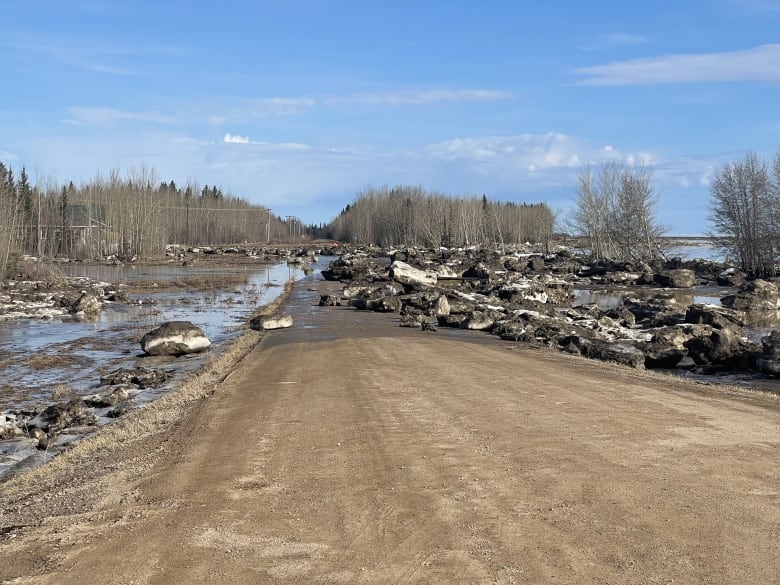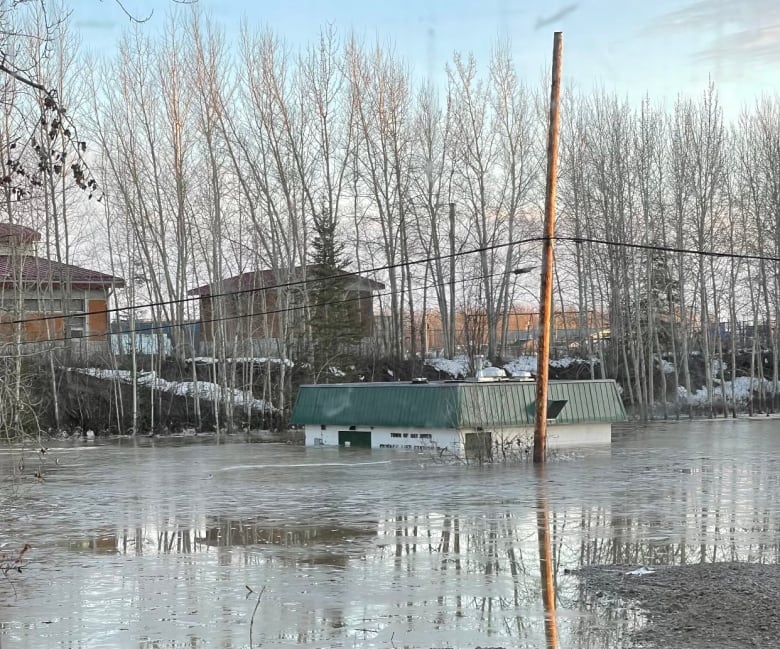Friday morning dawned clear and sunny on flood-ravaged Hay River and K’atl’odeeche First Nation in the N.W.T., where ice from the river’s breakup still litters the banks and roads of the communities.
The river itself had open water, with the last of the ice being carried off downstream.
Jane Groenewegen, who stayed in Hay River when it flooded Wednesday night, said breakup is almost over.
“We’re on the tail end now … except for the aftermath,” she said. “That is going to go on for a very long time.”
The two communities remain under an evacuation order, and residents who left are not yet being allowed back in.
Video footage shows ice moving down the Hay River at 10:37 p.m. Thursday, and ice-free waters in the same location at 5:54 a.m. Friday, May 13.
In an update Thursday night, the town said it was still focused on emergency response and hadn’t yet begun recovery efforts.
“Town infrastructure is significantly compromised affecting safe return in some areas of the community until addressed,” it said.
The town said water levels rose to new highs on Thursday and a second surge of water in the afternoon flooded through the north end of Miron Drive, the downtown area and Cranberry Crescent, causing property damage throughout the town.
Floodwaters also crippled the sewer system and knocked out power to the water treatment plant, meaning remaining residents are under a boil water advisory.

Emergency workers rescued multiple people.
The town said there was still an ice jam Thursday night, running six kilometres south from where the East and West channels converge — “the last of the remaining ice in the system.” Video and photos taken Friday morning at the bridge show no ice left on the river.
At the time of that update, which was issued at 8 p.m., the town still expected more surges of water to cause further flooding.
It noted emergency workers need to figure out what hazards need to be addressed before it can let people back in.
At Paradise Gardens, which was one of the first areas to flood between Hay River and Enterprise, water levels have gone down.
Groenewegen said Friday morning that trees, ice and debris are piled on the shoreline and the smell of diesel fuel from tanks that got washed away hangs in the air in some areas where the waters have receded.
She said there’s some frustration from residents who haven’t been able to get back into the community to check their homes.
“I think it’s going to be a slow process to get things back to what we call normal,” she said.
‘Trying to be as responsive as we can’
Shane Thompson, the N.W.T.’s minister of Municipal and Community Affairs (MACA), said residents will need to have patience as emergency workers focus on the immediate response to the flooding.
His department is co-ordinating the territorial response and helped work to set up evacuation centres. It’s helping to make sure communities hosting evacuees have food, medical supplies and anything else they need.
“We’re trying to be as responsive as we can,” he said. “We’ve got all the government departments working on that and we’re trying to make sure people are there.”

The government learned from last year’s floods in the Dehcho region that it needed to be better prepared, he added, and they’d begun preparing well in advance for breakup this year, bringing assessors on retainer early and having pathfinders in place to help community members navigate flood recovery.
Still, there was no way to tell ahead of time where floods would happen or what the scope of them would be.
“You have a plan, and then it gets worse than what we planned for,” Thompson explained. “Is there going to be shortfalls? Yeah, we know that.”
As officials have been saying from the start, emergency response comes first. The focus will switch to recovery efforts once it’s safe to do so.
“The thing is to be patient. We’re working with the town … and the federal government,” he said.
“We are working to get [residents] into their homes as soon as it’s safe and possible.”
Reference-www.cbc.ca
